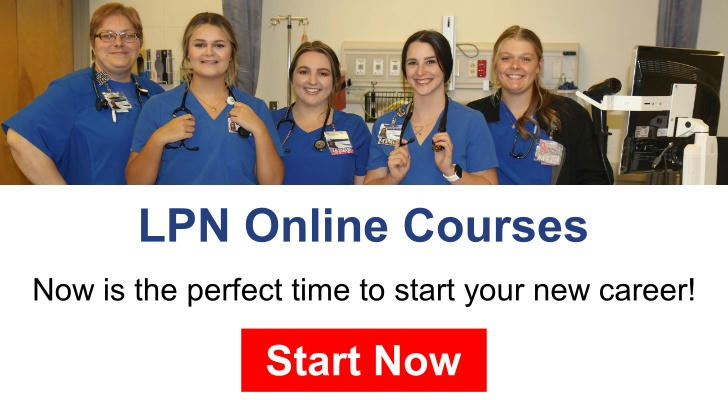LPN Online Courses
A licensed practical nurse (LPN), also known as a licensed vocational nurse (LVN) in some states, is an important member of the healthcare team, providing basic medical care under the supervision of a registered nurse (RN) or physician. Their work includes measuring vital signs, administering medications, changing dressings, and assisting patients with activities of daily living, such as eating and dressing. They typically work in settings such as hospitals, nursing homes, clinics, and private homes.

Government and Organizational Support
Recognizing the importance of LPNs in healthcare work, there are a variety of forms of support available to help students complete LPN programs:
Scholarships and Grants: Many organizations, including government agencies and private foundations, offer scholarships and grants. For example, according to Find Nursing Scholarships and Grants for LPN Program - TopNursing.org, Federal Pell Grants are available for LPN students who complete the FAFSA application. In addition, state scholarships such as New York's Edna A. Lauterbach Scholarship Fund also support LPN education.
Federal and State Financial Aid: Students can finance their education through federal and state financial aid programs, such as the Federal Work-Study Program and student loans.
Work-Study Program: Some educational institutions offer work-study programs that allow students to work part-time while studying to help pay for their education.
Employer Sponsorship: Some healthcare facilities offer sponsorship for LPN training to their employees, which may include tuition reimbursement or other financial incentives.
State-Specific Programs: Many states have their own initiatives to support nursing education, including LPN programs. For example, the US Department of Labor provides funding for nursing education in several states through the Nursing Extension Grant Program, which may include LPN programs, according to US Department of Labor awards $78M for nursing programs.
LPN Course Description
LPN courses are designed to provide students with the knowledge and skills they need to provide basic nursing care. According to Practical Nursing (LPN), Certificate - LaGuardia Community College, courses typically include:
Anatomy and Physiology: Learn about the structure and function of the human body.
Pharmacology: Learn about drug uses, side effects, and interactions.
Nursing Fundamentals: Includes patient assessment, infection control, and safety measures.
Medical-Surgical Nursing: Cares for adult patients with a variety of medical and surgical conditions.
Pediatric and Obstetric Nursing: Covers the care of children and pregnant women.
Psychiatric Nursing: Learn about mental health disorders and their treatment.
Clinical Practice: Practice in a medical setting, under supervision.
Career Requirements
Becoming an LPN requires completing a state-approved nursing training program, which usually lasts about one year. These programs are offered by community colleges, vocational schools, and some high schools, and the curriculum includes classroom instruction and clinical practice, covering topics such as anatomy, pharmacology, nursing fundamentals, and medical-surgical nursing. After completing training, students must pass the National Licensure Examination for Practical Nurses (NCLEX-PN) to obtain a license. Requirements may vary by state, so it is recommended to check with your state's board of nursing for specific information.
Prospects
According to the U.S. Bureau of Labor Statistics (BLS), employment of LPNs is expected to grow 5% from 2022 to 2032, faster than the average for all occupations. This growth is primarily driven by the increasing need for long-term care in an aging population. The median annual salary in 2022 is approximately $50,000, depending on location, experience, and work environment. LPNs can find work in a variety of settings, including hospitals, nursing homes, home health agencies, and schools.
Education and Licensure Requirements
The path to becoming an LPN typically includes the following steps:
Completion of a state-approved nursing program, which usually takes about a year. These programs are offered by vocational schools, community colleges, and some high schools.
Admission usually requires a high school diploma or equivalent (GED), and some programs may accept candidates without a diploma.
Upon completion of the program, you must pass the National Licensure Examination for Practical Nurses (NCLEX-PN) to obtain a license.
According to the Bureau of Labor Statistics - Licensed Practical and Licensed Vocational Nurses, these programs include classroom courses (such as biology, pharmacology, and nursing) and supervised clinical practice, providing hands-on experience in a hospital or healthcare facility.
Conclusion
LPNs are an important part of the U.S. healthcare system, providing primary care to patients, and are particularly in demand in nursing homes and long-term care settings. Despite the competition in the market, LPN is still a promising career for individuals who want to quickly enter the nursing field. Support from the government and organizations, such as scholarships and grants, has helped alleviate the cost of education, making this career accessible to more people.## LPN Career Introduction
